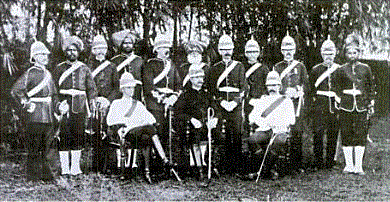
In January 2021, I had the opportunity to visit two local police stations, along with members of the Malaysian Red Crescent then helping with the flood relief program. In the police station in Skudai, the entrance hall was lined with old photos of the Johor Police Force, and as someone who loves looking at old photos, I took photos of these photos to look at later. Apparently, learning the history of the force is part of a policeman’s training.
Now I’m not a policeman, but I’ve been learning a bit about the policing of British Malaya in the late 19th century, as background material for a documentary on Isabella Bird who visited in 1879. Also, I came across some relevant characters in the museums as we travelled around Perak last year. The photo at the top of the page is of the Perak Armed Police 1890, clearly they’d put a bit of money into the operation by then since everyone is wearing rather smart uniforms. But in 1879, this operation was still a rough and tumble affair.
So there are three historically important characters of this time period to tell you a little about: Captain Speedy, Major Swinburne, and Colonel Walker. When the British came to Malaya, they soon found a need for some sort of law and order to look after their interests. According to Isabella Bird in the her book ’The Golden Chersonese and the Way Thither', the British jails were full of Chinese! They were always getting into trouble fighting each other. The Malays seemed to prefer small scale in-fighting and focussed on succession disputes. One feels that if the Malay rulers weren’t so intent on squabbling amongst themselves, they might have paid more attention to what the British were up too!
The Malays had been mining tin, but rather inefficiently, so they brought in the Chinese to scale up their operations and make more money for them. But rivallry between different clans had resulted in the first of four Larut Wars in 1861, ending with the signing of the Pangkor Treaty in 1874 and the initiation of the British Residency system in the Native States of Malaya.
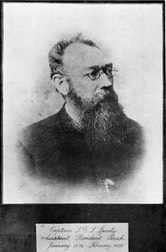
In 1871, Captain Tristram Charles Sawyer Speedy became the superintendent of Police in Penang. He was a colourful character, and you can read more about him in Lawrence’s blog on Day 14 of our Malaysian Road Trip 2020 eBook. He resigned from Penang in 1873 when he was recruited by Ngah Ibrahim, the Mentri (Chief Minister) of Larut (Taiping), to go there to restore order. In 1874 under the British he became Assistant Resident of Perak and stayed another four years. But, like many in the Residency system, he tended to make it up as he went along, and thus made many enemies as well as allies. If you want to read about a true 19th century adventurer, Captain Speedy is your man!
Major Paul Swinbourne is the character that Isabella Bird met in 1879, and he escorted her on a tour of Taiping; she was particularly interested in visiting the Chinese gambling dens. While I cannot find any photos of the man, I do have Isabella’s description, part of which I will give you here: He is a brilliant, fascinating and altogether misplaced person. His first words to Isabella were, “The sooner you go away again, the better; there’s nothing to do and nothing to learn.” To the Malays, he was known as ‘The Mad One’ and ‘The Outspoken One’, but they admired him as was noted by the great farewell they gave him. In his farewell speech to his men, he said, “You are a lot of unmitigated scoundrels; half of you deserve hanging; but keep out of scrapes if you can till I come back, that I may have the pleasure of hanging you myself.” He really did like them!
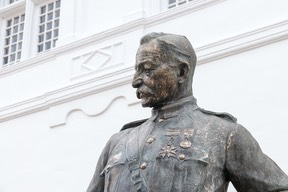
In 1879, the ex-England footballer, Colonel Robert Sandilands Frown Walker took command of the Perak Armed Police from Major Paul Swinbourne, and you can read more about Colonel Walker on Lawrence’s blog on Day 18 of our Malaysian Road Trip 2020 eBook. There’s a dramatic statue of the man outside the Perak State Museum in Taiping, and he is diametrically opposite to Speedy in character.
Colonel Walker turned the Perak Armed Police into a quasi-military force composed of Sikh and Pathan recruits. These ex-Indian Army soldiers had been used by the British in the Straits Settlements, and their discipline and fearsome character were much admired by the far-outnumbered overstretched British administrators. Later one finds local Malays being recruited in the Police service, but according to Isabella Bird and her contemporary author Emily Innes in her book ’The Chersonese with the Gilding Off', they did have a tendency to run away at the first sign of trouble.
According to Wikipedia, a police force has been in existence in Malaysia since the 15th century. But the police force we are familiar with today is based on policing in the British Empire as established in Penang in 1807. One of the outcomes of introducing the British way of policing into Malaya was the movement of population into districts ‘protected’ by the British, and this applied to both Malays and Chinese. The Malay workers were now protected from the arbitrary decisions of the Malay rulers, and the Chinese businessmen understood the value of contracts supported by the Court of Law. The lowly Chinese workers stayed controlled by their clan (triad) leaders and no Englishman would interfere with that relationship.
As for the Johor Police Force, apparently a book was written about their history and it can be found at the Johor police headquarters for their ‘meet the customers day’ programme. I doubt I will ever be such a ‘customer’ so let's look at some of the photos I took in the Skudai police station. I think the photos speak for themselves.
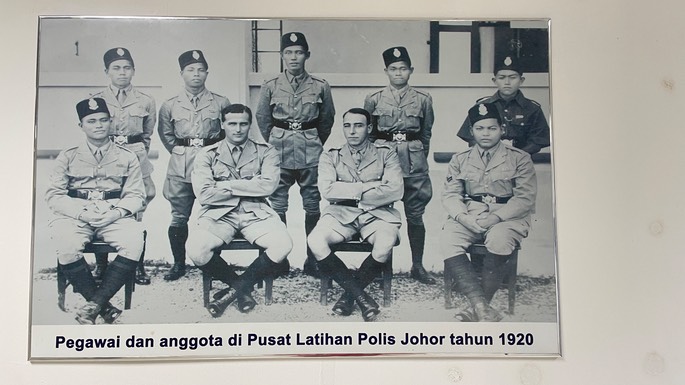
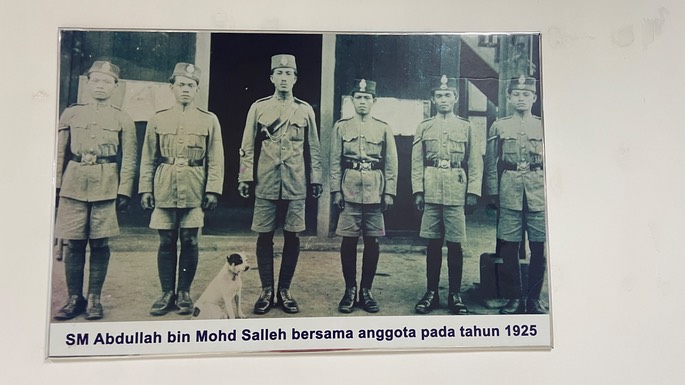
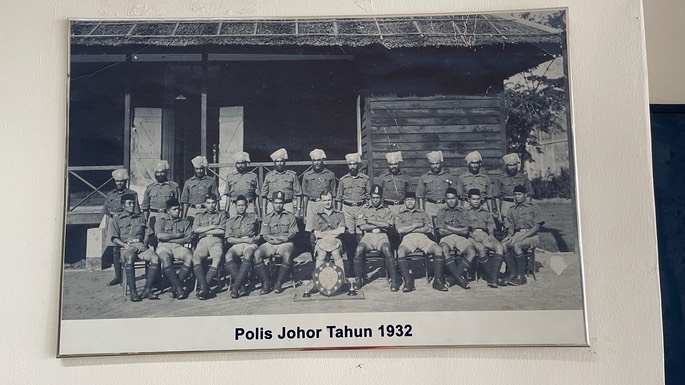
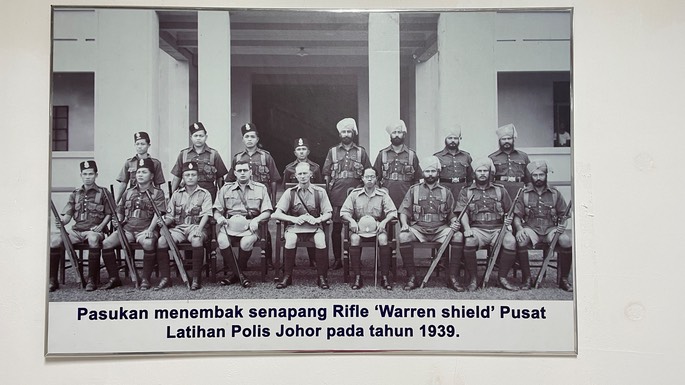
Clearly everything changed after World War 2, so perhaps it was considered politically correct to stop the photo collection at 1939, or perhaps I just missed that collection of photos. Anyway, the role of the police force during the war and in the Emergency period is a fascinating topic which has been much written about and is out of the scope of my topic here.
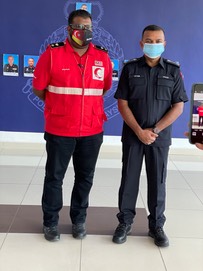
Today, the Royal Malaysia Police wears many hats. The current Chief of Police in Johor is Datuk Ayob Khan Mydin Pitchay, well known to locals for his anti-terrorism work. When I visited the main Police Headquarters in Johor Bahru with members of the Malaysian Red Crescent Disaster Relief Force, one of the volunteers from Kuala Lumpur asked the Chief of Police if he could have his photo taken with him as he was his hero! Apparently his stand on corruption is widely appreciated.
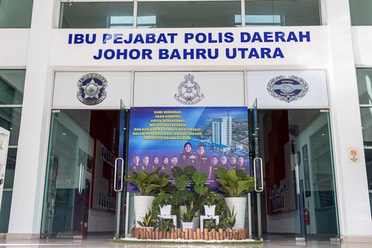
The Johor Police are also very much part of their local community, and that is why I was visiting a police station in Skudai. Here, the ACP Rupiah binti Abd Wahid, Officer in Charge of northern Johor Bahru district (shown centre stage in the photo above), had contacted the Malaysian Red Crescent for help with residents affected by the new year floods (see blog about Community Service). This type of police work takes us right back to the beginning of this story. When I saw the devastation caused by the floods, I naturally felt sorry for the residents. But others viewed this differently because they considered the residents as squatters. So, even today, the police are still having to contend with the problems of land rights.
Click here to return to Travels in Malaysia 2021.
Click here to return to Helen Gray’s homepage.